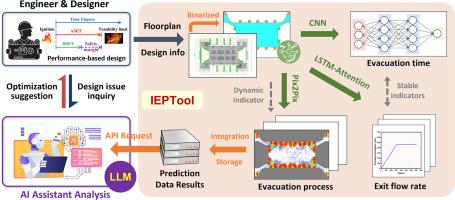大型基础设施智能疏散安全分析的人机交互框架
IF 11
1区 工程技术
Q1 ENGINEERING, INDUSTRIAL
引用次数: 0
摘要
大型城市基础设施的规模和复杂性日益增加,导致行人更加集中,在紧急情况下发生与人群有关的事件的风险也更高。本研究开发了一个具有人机交互框架的智能疏散预测工具(IEPTool),用于大型基础设施的疏散预测和安全评估。该工具配备了一个深度学习引擎,该引擎是从66个真实建筑平面图的综合疏散模拟数据库中训练出来的,包括机场航站楼、展览中心、大型体育场馆和各种车站。通过整合长短期记忆(LSTM)网络和生成对抗网络(GANs),以90%以上的准确率预测疏散时间、每个出口的行人流量和动态行人密度分布等关键指标。随后,引入大型语言模型(LLM)进行交互式风险分析,实现智能疏散安全评估,并提供优化指导。集成的图形用户界面可以快速准确地评估复杂平面图的疏散安全性。该智能框架为消防安全设计分析和城市韧性管理提供了实用可靠的支持。本文章由计算机程序翻译,如有差异,请以英文原文为准。

Human-AI interactive framework for smart evacuation safety analysis in large infrastructures
The increasing scale and complexity of large urban infrastructures have led to greater pedestrian concentrations and high risks of crowd-related incidents in emergencies. This study develops an Intelligent Evacuation Prediction Tool (IEPTool) with a human-AI interactive framework for evacuation prediction and safety assessment in large infrastructures. The tool is equipped with a deep learning engine trained from a comprehensive evacuation-simulation database of 66 real-life architectural floor plans, including air terminals, exhibition centers, large stadiums, and various stations. By integrating long-short-term memory (LSTM) networks and generative adversarial networks (GANs), key metrics, including evacuation time, the pedestrian flow rate at each exit, and dynamic pedestrian density distribution, are predicted with a high accuracy of over 90 %. Subsequently, a large language model (LLM) is incorporated for interactive risk analysis, enabling intelligent evacuation safety assessments and providing optimization guidance. The integrated graphical user interface allows fast and accurate evaluation of evacuation safety for complex floorplans. This intelligent framework provides practical and reliable support to fire safety design analysis and urban resilience management.
求助全文
通过发布文献求助,成功后即可免费获取论文全文。
去求助
来源期刊

Reliability Engineering & System Safety
管理科学-工程:工业
CiteScore
15.20
自引率
39.50%
发文量
621
审稿时长
67 days
期刊介绍:
Elsevier publishes Reliability Engineering & System Safety in association with the European Safety and Reliability Association and the Safety Engineering and Risk Analysis Division. The international journal is devoted to developing and applying methods to enhance the safety and reliability of complex technological systems, like nuclear power plants, chemical plants, hazardous waste facilities, space systems, offshore and maritime systems, transportation systems, constructed infrastructure, and manufacturing plants. The journal normally publishes only articles that involve the analysis of substantive problems related to the reliability of complex systems or present techniques and/or theoretical results that have a discernable relationship to the solution of such problems. An important aim is to balance academic material and practical applications.
 求助内容:
求助内容: 应助结果提醒方式:
应助结果提醒方式:


